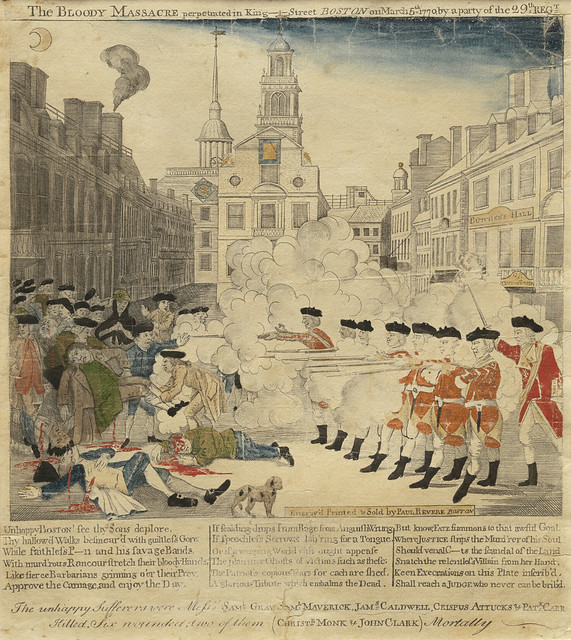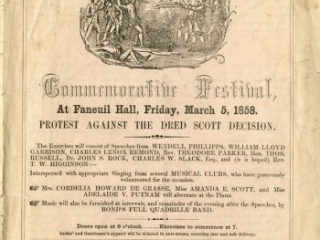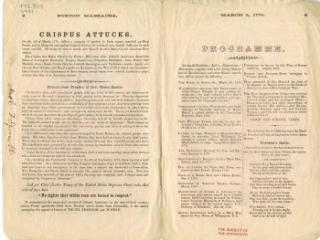George Pagano, Park Slope Educational Complex at Middle School 88, Brooklyn, New York
DESIGN LEVEL: Middle School

Overview
The road to American independence was paved by many heroic figures. In this lesson, students will develop a deeper understanding of the themes of independence and legacy through a case study of an early martyr of the American Revolution, Crispus Attucks. This activity will enhance students’ awareness of the sacrifices made for the ideals of the Revolution.
Objectives
Students will . . .
- Read and analyze a primary source text, identifying key words.
- Collaborate effectively with classmates in small groups to explain, interpret and evaluate information presented by the literary and visual source materials in this lesson.
Materials
- “The Bloody Massacre,” Paul Revere, 1770, The Diplomatic Reception Rooms, U.S. Department of State.
- Boston Massacre, March 5th, 1770: The Day which History Selects as the Dawn of the American Revolution. Commemorative Festival, at Faneuil Hall, Friday, March 5, 1858. Protest against the Dred Scott decision … (Boston: Press of E. L. Balch, 1858). The Society of the Cincinnati, The Robert Charles Lawrence Fergusson Collection. [Images in gallery below.]
- William C. Nell speech, March 5, 1862.
- Boston Massacre, March 5, 1770, Henry Q Smith, 1856, Boston Athenaeum.
Recommended Time
One 60-minute class period online.
Activity
The teacher will initiate the lesson by prompting students to state the meaning of two key terms: independence and legacy. The teacher will provide feedback to students’ responses and refine the meanings of both words.
The teacher will describe the events that occurred on March 5, 1770 known as the Boston Massacre and its significance as the start of the American Revolution. The engraving of Paul Revere’s Bloody Massacre will be shared as a visual aid.
The teacher will share the pamphlet from the Robert Charles Lawrence Fergusson collection announcing the 1858 commemoration of the Boston Massacre in memoriam of Crispus Attucks and “the names and services of Colored Americans in the war of their country, and to Protest against the Dred Scott Decision.” The themes of legacy, independence and sacrifice will be exemplified in telling the story of Crispus Attucks—the symbolic embodiment of black patriotism and freedom, nicknamed “the first martyr of the Revolution.”
Students will then read an excerpt from William Cooper Nell’s 1862 speech at a commemoration of the Boston Massacre. Students will be divided into breakout groups. In their groups, students will take turns reading the passage and respond to the following three questions:
- What was Nell’s message in his speech?
- Why was this message important in 1862?
- Nell used the legacy of Crispus Attucks during this event which was billed as a protest against the Dred Scott Decision. Can it be used today?
The class will come together to discuss and share their responses.
As a culminating activity, students will be asked to write a short obituary of Crispus Attucks based on the information learned during the lesson.
Assessment
The students will respond and convey their positions on the lesson’s essential questions. Their responses as well as their Crispus Attucks obituary will be reviewed by the teacher as an evaluation of student learning and understanding.
Extensions
Students will be shown Bufford’s 1856 lithograph of the Boston Massacre and asked to answer the following:
- How is Attucks depicted in this lithograph?
- What are the similarities and differences from Revere’s engraving?
- How does time affect the telling of a story?
- What did the artist of each image want to convey?
Standards Addressed
COMMON CORE: English Language Arts Standards—History/Social Studies—Grade 6-8
Key Ideas and Details:
CCSS.ELA-LITERACY.RH.6-8.1
Cite specific textual evidence to support analysis of primary and secondary sources.
CCSS.ELA-LITERACY.RH.6-8.2
Determine the central ideas or information of a primary or secondary source; provide an accurate summary of the source distinct from prior knowledge or opinions.
CCSS.ELA-LITERACY.RH.6-8.3
Identify key steps in a text’s description of a process related to history/social studies (e.g., how a bill becomes law, how interest rates are raised or lowered).
Craft and Structure:
CCSS.ELA-LITERACY.RH.6-8.4
Determine the meaning of words and phrases as they are used in a text, including vocabulary specific to domains related to history/social studies.
CCSS.ELA-LITERACY.RH.6-8.5
Describe how a text presents information (e.g., sequentially, comparatively, causally).
CCSS.ELA-LITERACY.RH.6-8.6
Identify aspects of a text that reveal an author’s point of view or purpose (e.g., loaded language, inclusion or avoidance of particular facts).
Integration of Knowledge and Ideas:
CCSS.ELA-LITERACY.RH.6-8.7
Integrate visual information (e.g., in charts, graphs, photographs, videos, or maps) with other information in print and digital text.

Boston Massacre, March 5th, 1770: The Day which History Selects as the Dawn of the American Revolution. Commemorative Festival, at Faneuil Hall, Friday, March 5, 1858. Protest against the Dred Scott decision …[pg. 1]
1858The Society of the Cincinnati, The Robert Charles Lawrence Fergusson Collection

Boston Massacre, March 5th, 1770: The Day which History Selects as the Dawn of the American Revolution. Commemorative Festival, at Faneuil Hall, Friday, March 5, 1858. Protest against the Dred Scott decision …[pg. 2-3]
1858The Society of the Cincinnati, The Robert Charles Lawrence Fergusson Collection

